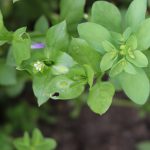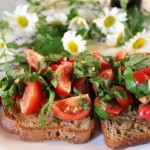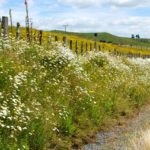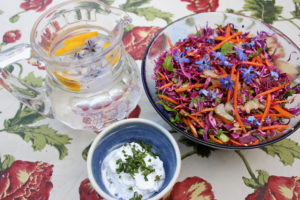
Borage ice cubes, borage in a salad and coconut cream.
The beauty and fragrance of flowers have always drawn humans in nourishing our senses. Increasingly we see a trend to use colourful flowers to brighten and make food very attractive. This though is far from a new idea. Ancient Greek, Roman and Chinese herbalists recorded medicinal and culinary uses for flowers. There is also information on the use of edible flowers from the medieval and Victorian periods where salads were made using violets, daisies and borage. Cakes were baked with rosewater and elderflower vinegar. Sage flowers, lavender and peonies were made into preserves with added medicinal qualities. Later it became very popular to ‘candy’ all sorts of flowers other than violets.
Adding edible flowers enhances salads with colour, texture and flavours. Even a simple dish inspires creativity turning a cook into an artist transforming any meal into a celebration. Not only uplifting and pretty many edible flowers are high in nutrients, antioxidants and anti-inflammatory properties.
Growing your own edible flowers is a wonderful way to get children interested in gardening giving them a sense of achievement when they’ve grown something themselves. Flowers can also get children excited about food, and it only takes a few bright edible petals to turn any food into an imaginary fairy feast.
Guidelines for using edible flowers safely:
- Correctly identify the flower before eating it. Eat only the petals unless you know the whole flower is edible.
- Pick from unsprayed, clean locations
- Pick your flowers early or late in the day when their moisture content is highest and the flavour is best. Pick newly opened flowers not old mature or blemished flowers. Check for insects e.g. ants, if you lay them for a while ants will leave
- Best eaten fresh on the day but they will keep in the fridge in a sealed container for 2-3 days.
Alyssum Lobularia maritima
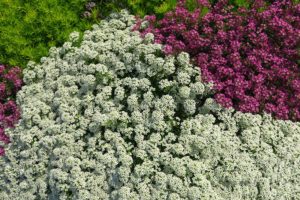
Alyssum flowers
Common in gardens as a ground cover, border plant, between paving stones or in pots. It attracts beneficial insects, hoverflies, bees and butterflies.
Leaves, stems and flowers can be used in salads. The white, purple or pink flowers are mildly hot and savoury tasting and stunning as a garnish.
Borage Borago officinalis
Borage flowers are bright blue and star shaped. The mineral rich leaves have a cucumber like flavour are hairy, but cut finely enrich salads, soups and smoothies. The seeds taste of oysters. The flowers with a sweet
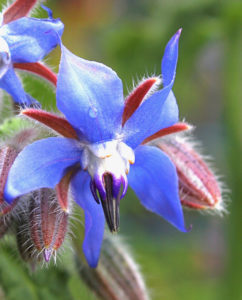
Borage flower
honey-like flavour are used mostly as a garnish on desserts or frozen like jewels in ice cubes for garnishing drinks.
Calendula Calendula officinalis
Yellow or orange flowers have a mild, tangy taste, slightly peppery and the centre is stronger. They add colour and taste to a salad and dried or fresh enrich the colour of rice or butter. The fresh young leaves can be used sparingly in salads. Medicinally infused
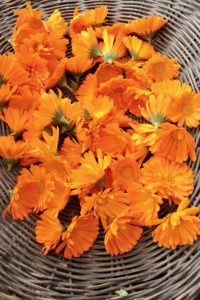
Calendula flowers
in oil calendula flowers heal wounds and cuts.
Wild Fennel Foeniculum vulgare
All parts of the fennel plant are edible, from the tender leaves to the plump seeds both aniseed flavoured. Florence fennel has fat bulbs, delicious sliced into salads. Fennel flowers brighten salads, baked dishes and the yellow pollen
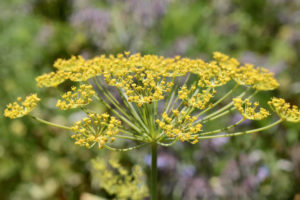
Fennel flower
can be harvested and used in baking.

